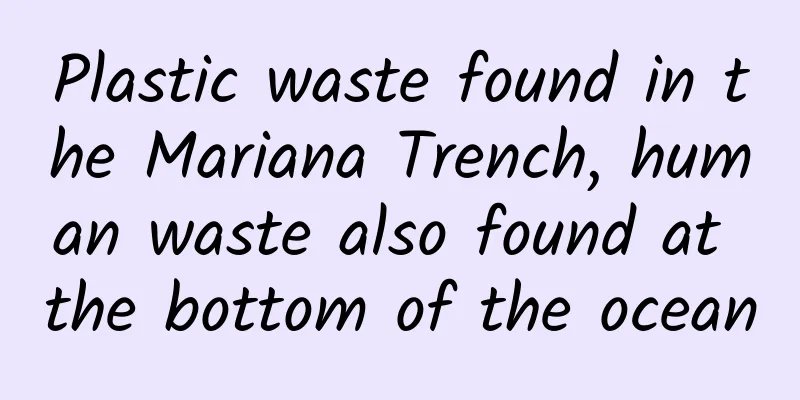Plastic waste found in the Mariana Trench, human waste also found at the bottom of the ocean

|
In fact, this is not the first time that the scientific expedition team has discovered plastic waste in the deep ocean. Only this time it was at the lowest seabed on Earth – the Mariana Trench. In fact, such complete "plastic corpses" are relatively rare in the deep sea, because most plastics are degraded into plastic particles in the sea. Image source: MBARI Since the invention of plastic in the 1940s, this versatile polymer has rapidly gained popularity around the world due to its ease of use, light weight and moderate durability. However, with the large-scale use of plastic products, the problem of material disposal after use has arisen. Plastics are generally disposable and are discarded after use. But the problem is that plastic is difficult to degrade naturally. It often takes decades or even hundreds of years for plastic to degrade naturally into harmless substances. So where should the large amount of plastic waste be dumped? What is the largest place in the world? Of course it is the ocean. In ancient times, there was Jingwei filling the sea, and now there are plastics sinking into the sea. Yes, most of the waste generated by human activities ends up in the ocean. According to statistics from the United Nations Environment Programme, more than 8 million tons of plastic waste are discarded into the ocean every year, accounting for 80% of marine waste, which has threatened the survival of marine wildlife. What kind of threat? Of course, "enter their bodies..." After plastic waste is dumped into the sea, large pieces of plastic will gradually become smaller due to natural factors such as solar radiation, chemical degradation, and wave impact, turning into countless small plastic particles. Particles smaller than 5mm are defined as microplastics. These microplastics are very small and can be easily swallowed by marine organisms. In recent years, a lot of research on microplastic pollution in the marine environment has been carried out both at home and abroad. A research team from the Monterey Bay Aquarium and Research Institute used remote tools and specially designed samplers to collect data on the distribution of microplastics in the deep waters of Monterey Bay. Image source: MBARI They collected 26,000 litres of seawater from depths of 5 to 1,000 metres, as well as biological samples of pelagic red crabs and giant larval sea squirts – both animals that feed on particles of the same size as microplastics. The findings show that polyethylene terephthalate (PET), found in single-use plastic bottles and packaging, was the most common plastic found in water column samples at all depths. It is also the most common plastic found in the gastrointestinal tract of pelagic red crabs and in the discarded slime meshes of larval ascidians. The mesh of larvae is called a sac, which is discarded after each meal and sinks to the bottom of the sea. In this way, microplastics are slowly "transported" from shallow waters to deep seas, and the housing cysts of larval tunicates are equivalent to a carrier, "responsible" for transporting microplastics to deeper seabeds. But many people living inland may not have much idea about microplastics in the ocean. Because many previous studies have focused on the ocean, data on freshwater microplastic pollution is relatively scarce. Under the guidance of his supervisor, Wang Wenfeng, a doctoral student from the Wuhan Botanical Garden of the Chinese Academy of Sciences, investigated the microplastic pollution in China's inland freshwater - taking Wuhan, the largest city in central China, as an example. The study mainly investigated the content of trace plastics in the surface water of 20 urban lakes in Wuhan and urban rivers of the Han River and the Yangtze River. For the surveyed waters, the concentration of microplastics ranged from 1660.0±639.1 to 8925±1591n/m3, with the highest concentration in the North Lake. The study not only shows that microplastic pollution does exist in Wuhan’s lakes, but also has spatial characteristics. That is, the abundance of microplastics in the water decreases from lakes in the center of the city to lakes in the periphery, which confirms the important influence of human factors on the distribution of microplastics in urban lakes. In the waters surveyed, the main type of microplastic was colored plastic, with fibers being the most common shape. Polyethylene terephthalate and polypropylene were the main polymer types of the microplastics analyzed. SEM image of particles Having said so much, I believe that what everyone is most concerned about is the impact on humans. In fact, the most terrifying thing about microplastics is that they will become carriers of other pollutants and form complex pollutants. For example, they will combine with heavy metals, polycyclic aromatic hydrocarbons, and polychlorinated biphenyls. Most of these pollutants are harmful to the human body. The "birth environment" of microplastics determines that very few of them can "come out of the mud without being stained", perhaps they are also helpless. |
<<: This is more damaging to the battery and more dangerous than charging it overnight!
>>: The "stumbling" robot dog died in just one hour...
Recommend
China Association of Automobile Manufacturers: The top ten Chinese automobile sales companies (groups) sold a total of 23.148 million vehicles in 2022
Recently, the China Association of Automobile Man...
Worse than staying up late! How harmful is “fragmented sleep”?
Review expert: Wang Xuejiang, professor at Capita...
Dou Jingbo of Suning.com: The evolution of mobile clients
On August 26-27, 2016, the [WOT2016 Mobile Intern...
What can you calculate by observing the stars at night and counting with your fingers?
Author: Chen En (Purple Mountain Observatory, Chi...
2,500 times a year, how many people are risking their lives to "go to the toilet"? !
Source: Life Times Review | Tang Qin Deputy Secre...
New traffic diversion methods in 2020 and 6 implementation steps!
Behind every search action and every click is a l...
How to write an integrated marketing communication case?
Last year, I wrote an article titled "How to...
China Association of Automobile Manufacturers: Economic Operation of the Automobile Industry in November 2022
In November 2022 , China's automobile product...
Getting Swiss watches into trouble: Did Apple pick the wrong target?
As Apple's new product launch on September 9 ...
Electric Technology Car News: Wuling, Changan, Dongfeng and other brands are competing to see who can become the overlord in the field of home MPV
Since the second-child policy was implemented, mo...
Why can't an adult's heart regenerate? Scientists: Actively refuse
The liver has the greatest regenerative capacity ...
Summary of Xiaohongshu’s operation and promotion methods!
Traffic exposure 1. The traffic for the note I po...
Microsoft explains iOS app porting project: Sandbox-free access to Win10 API
Currently, Microsoft's Android application po...
The sales target of Xiangjie S9 this year is 60,000 units. Is this the only battle that will determine the success of BAIC Motor, which suffered a loss of 25 billion yuan?
"This car competes with the Mercedes-Benz S-...
PPA Intelligent Driving Covers 105 Cities, and the V1.5.0 version of Jiyue has been fully pushed to vehicles
"Full push of V1.5.0 version", "6t...









